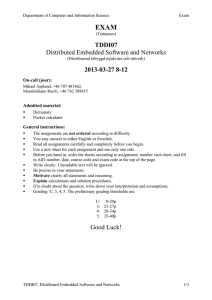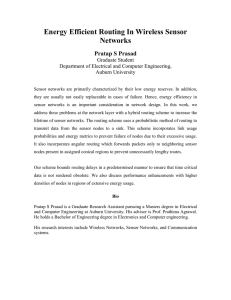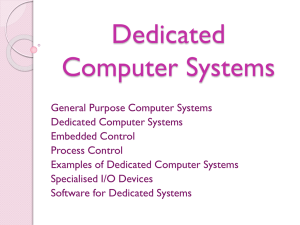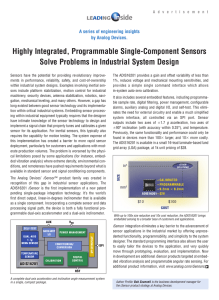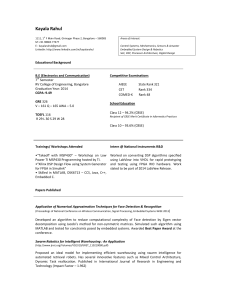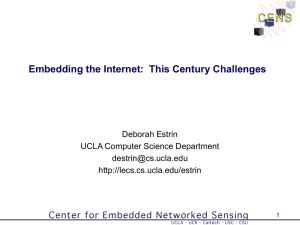EXAM TDDI07 Distributed Embedded Software and Networks
advertisement
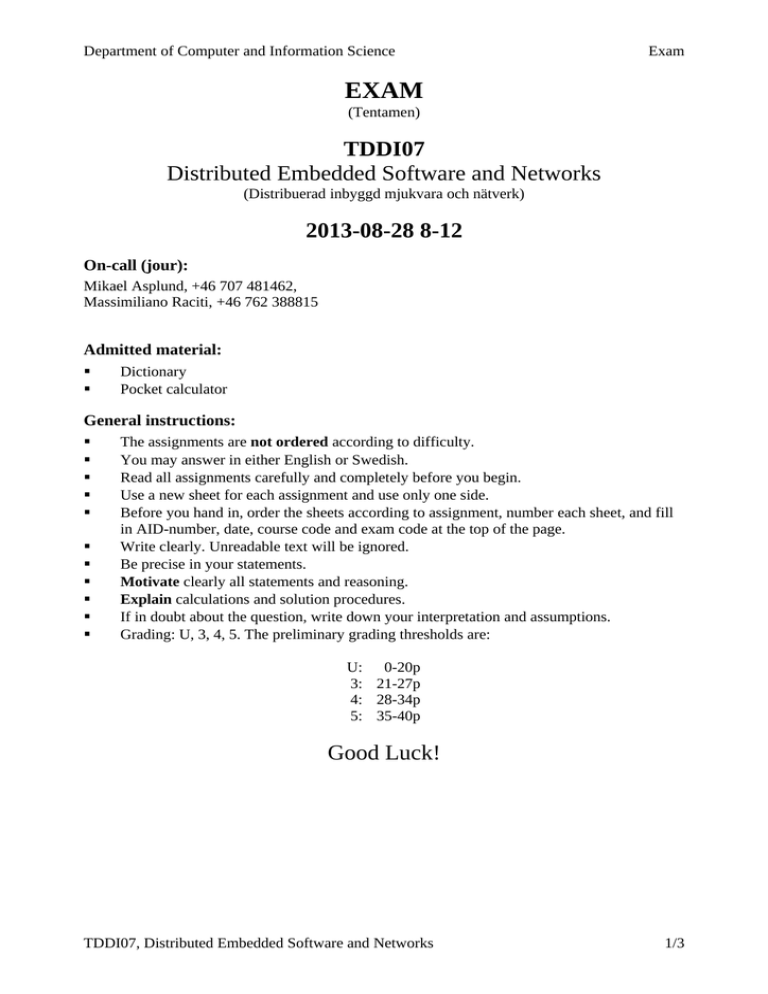
Department of Computer and Information Science Exam EXAM (Tentamen) TDDI07 Distributed Embedded Software and Networks (Distribuerad inbyggd mjukvara och nätverk) 2013-08-28 8-12 On-call (jour): Mikael Asplund, +46 707 481462, Massimiliano Raciti, +46 762 388815 Admitted material: Dictionary Pocket calculator General instructions: The assignments are not ordered according to difficulty. You may answer in either English or Swedish. Read all assignments carefully and completely before you begin. Use a new sheet for each assignment and use only one side. Before you hand in, order the sheets according to assignment, number each sheet, and fill in AID-number, date, course code and exam code at the top of the page. Write clearly. Unreadable text will be ignored. Be precise in your statements. Motivate clearly all statements and reasoning. Explain calculations and solution procedures. If in doubt about the question, write down your interpretation and assumptions. Grading: U, 3, 4, 5. The preliminary grading thresholds are: U: 0-20p 3: 21-27p 4: 28-34p 5: 35-40p Good Luck! TDDI07, Distributed Embedded Software and Networks 1/3 Department of Computer and Information Science Exam 1. Fundamentals (6p) Consider a system designed to monitor the humidity and temperature in a number of large green-houses with total area of 10.000 m. 1000 sensors are deployed both in the soil and in the surrounding environment. Due to cost and maintenance reasons, the sensors should be wireless and equipped with batteries that lasts at least two years. a) Comment on the advantages and disadvantages of using a single-hop or multi-hop network in this scenario (2p) b) Each sensor runs at 3.3V, is equipped with a 2000mAh battery and consumes 100mW when active. Assume that the power consumption during sleep mode can be approximated to zero, determine an appropriate duty cycle for the sensor nodes. (2p) c) For every reading, the sensors take a number of samples which are averaged to remove random noise in the sensor component. Where should this average be calculated, in the sensor node, or in a central server with better processing capabilities? (Remember to always motivate your answer) (2p) 2. Medium Access Control (6p) a) Explain the exposed-terminal problem and discuss a potential solution. (2p) b) The Aloha protocol was one of the first medium access control protocols, where a message was simply sent whenever the sender had something to send. A significant performance improvement can be made by only transmitting during predefined time-slots. Explain this fact. (2p) c) Describe two (there are five in total) energy problems that a MAC protocol can have. 3. Routing and Data Collection (5p) a) Location-based (or geographic) routing can significantly outperform flat routing schemes under some circumstances. Why? Are there any drawbacks? (2p) b) Describe three different metrics which can be used when assessing whether a routing protocol is energy-efficient. (3p) 4. Cellular Networks (4p) a) What is meant by time-tolerant traffic? Give and example of an application with this type of traffic. (2p) b) The European e-Call directive which will require all new cars to be equipped with a module that can automatically report to emergency services in the event of a collision, relies on the GSM standard for communication. Comment on possible explanations of this choice (2p). TDDI07, Distributed Embedded Software and Networks 2/3 Department of Computer and Information Science Exam 5. Clock Synchronisation and Positioning (5p) a) Consider the following clock timestamps of the same event e: C1(e)=3, C2(e)=8, C3(e)=9, C4(e)=12. Assuming that the latency for messages in the network varies from 0.01 to 0.02 seconds, that the drift rate of the clocks is negligible, and that all nodes really observed the event at the same time. How well can the clocks be synchronised? (3p) b) Give two different strategies for an embedded sensor/actuator device to determine its position. (2p) 6. Resource Management (5p) a) Explain the three parameters, bucket size b, peak rate p, and arrival rate r of the token bucket shaper. Relate each of the parameters to characteristics of the outgoing traffic. (3p) b) What is meant by over-provisioning? Comment on the ability of this mechanism to enable quality of service for the end user. (2p) 7. Dependability and Security (5p) a) Explain the terms fault, error and failure, and describe how they are connected. (3p) b) Describe the meaning of an active and passive attack, respectively. Give an example of each type (2p). 8. Energy Management (4p) a) Reactive energy-saving approaches can be categorised as timeout-based, inference-based, and stochastic. Describe each category. (3p) b) Briefly describe dynamic voltage scaling. (1p) TDDI07, Distributed Embedded Software and Networks 3/3

